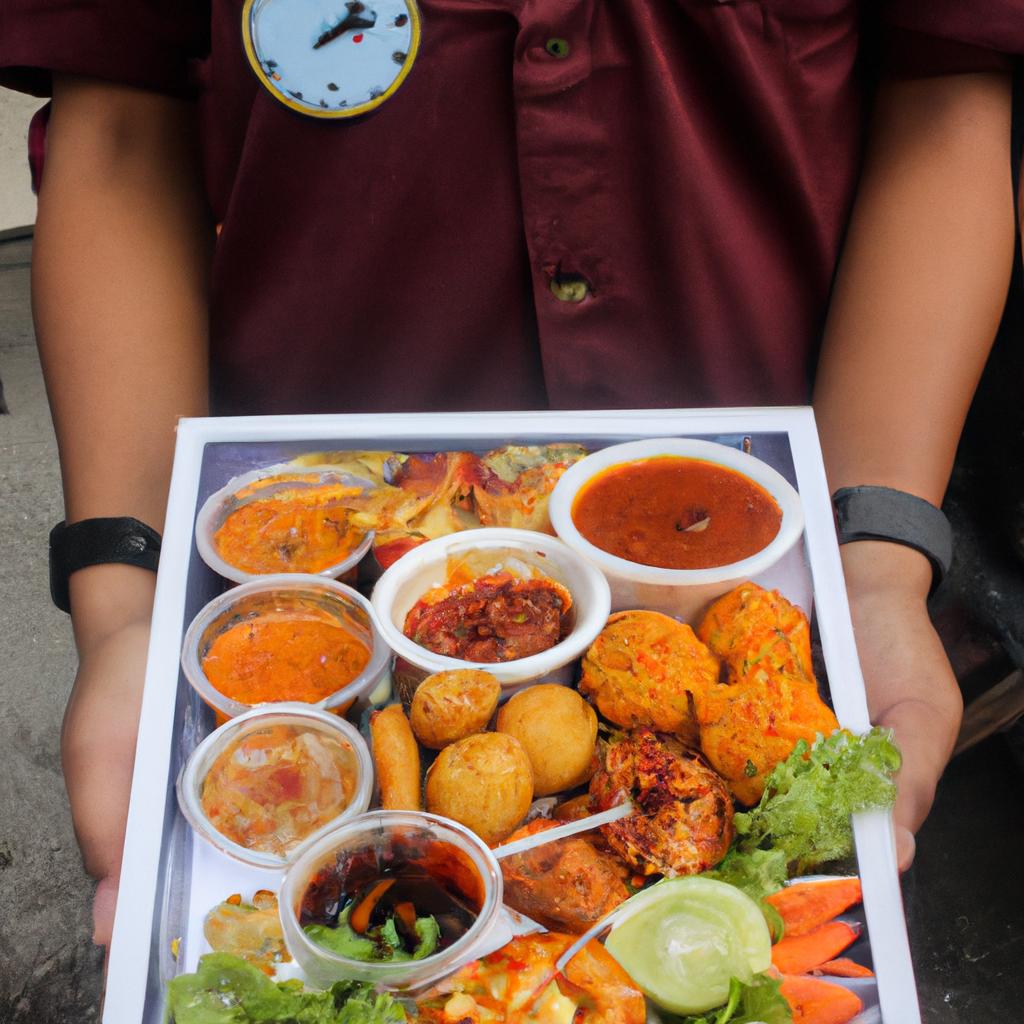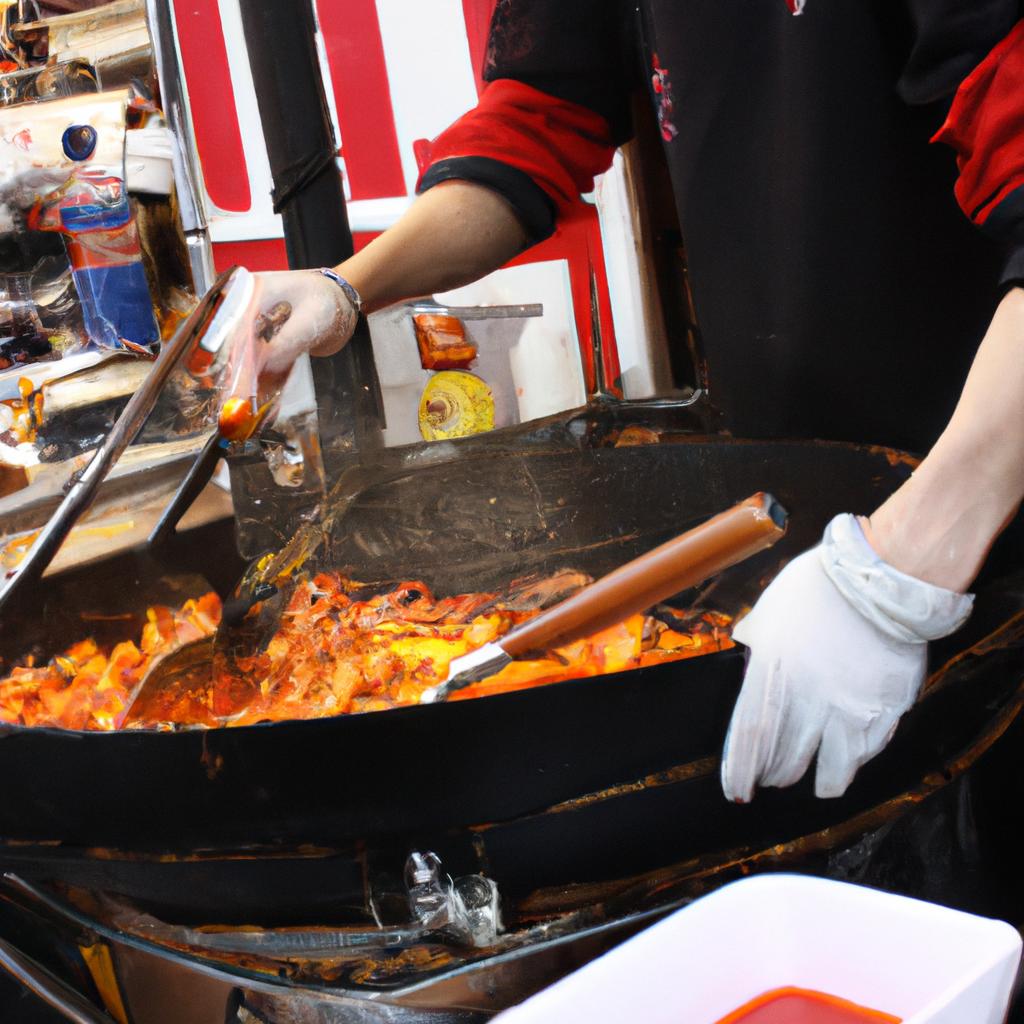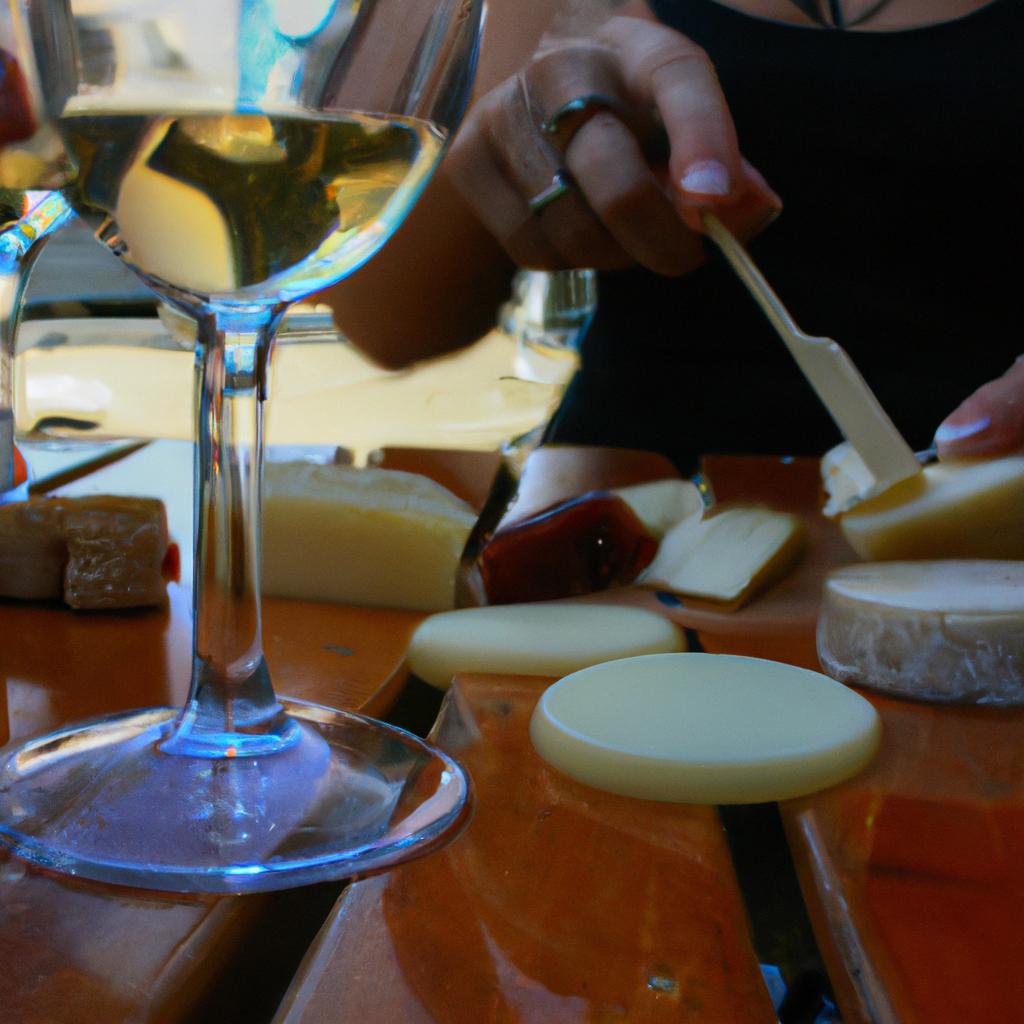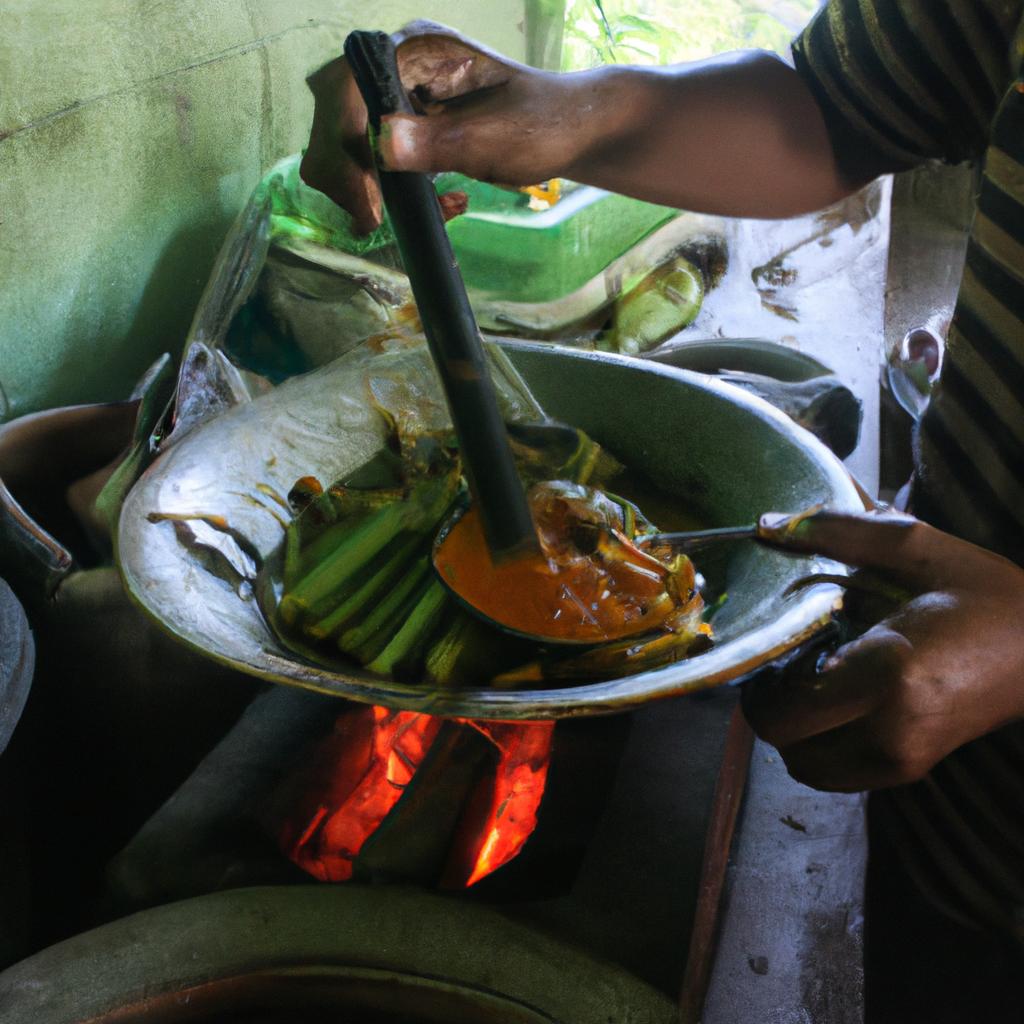Food is an essential aspect of any culture and exploring local cuisine through food tours can be a delightful way to experience a destination. These guided excursions provide individuals with the opportunity to delve into the flavors, history, and traditions of a specific region’s culinary offerings. For instance, imagine yourself wandering through the bustling streets of Bangkok, Thailand, surrounded by aromatic street food stalls offering delectable dishes such as pad Thai or green curry. By participating in a food tour, you would not only savor these mouthwatering delicacies but also gain insights into the cultural significance behind each dish.
Food tours offer more than just indulgence in delicious meals; they serve as windows into understanding a locality’s unique gastronomy. These experiences are designed to allow visitors to immerse themselves in the rich culinary heritage that reflects the customs and traditions of a particular community. The informative guides accompanying participants on these tours share anecdotes about the origins of various recipes, highlighting connections between historical events and regional ingredients. This educational aspect adds depth to one’s exploration of local cuisine, fostering appreciation for the intricate relationship between food and culture while satisfying both curiosity and taste buds.
Through this article, we will explore different aspects of local cuisine food tours – from their benefits to how they contribute to sustainable tourism practices. Food tours not only provide an opportunity to sample authentic and traditional dishes but also support local businesses and promote sustainable tourism.
One of the key benefits of food tours is their contribution to the local economy. By participating in these guided excursions, travelers directly support small-scale local food vendors, street stalls, and restaurants. This financial injection helps sustain these businesses, preserving culinary traditions that have been passed down through generations. Additionally, food tours often prioritize partnerships with locally-owned establishments, ensuring that tourist dollars benefit the community directly.
Food tours also play a role in promoting sustainability within the tourism industry. Many reputable food tour companies have a focus on responsible consumption and minimizing waste. They may emphasize the use of fresh, locally-sourced ingredients and educate participants about sustainable farming practices or seasonal produce. These initiatives not only reduce carbon footprints but also encourage tourists to make more conscious choices about their own food habits.
Furthermore, food tours can foster cultural preservation by showcasing traditional cooking methods and rare regional recipes. Some tours even include visits to local markets where visitors can learn about indigenous ingredients and witness traditional cooking techniques firsthand. By highlighting these cultural aspects of cuisine, food tours contribute to the safeguarding of intangible heritage while promoting cross-cultural understanding and appreciation.
In addition to supporting local businesses and promoting sustainability, food tours are often designed to be interactive experiences that engage all senses. Participants get hands-on opportunities like preparing traditional dishes or learning how to properly eat certain foods using local customs. These immersive activities create lasting memories while deepening one’s connection with the destination.
In conclusion, exploring local cuisine through food tours offers a multi-faceted experience that goes beyond mere indulgence in delicious meals. It provides an avenue for cultural immersion, supports local economies, promotes sustainable practices, preserves culinary traditions, and fosters cross-cultural understanding. So next time you find yourself planning a trip to a new destination, consider adding a food tour to your itinerary and embark on a culinary adventure that will leave you with a richer understanding of the local culture.
What are food tours?
Imagine yourself strolling through the bustling streets of a vibrant city, surrounded by tantalizing aromas and mouthwatering dishes from various cultures. Suddenly, you come across a charming food tour that promises to take you on an unforgettable culinary adventure. But what exactly is a food tour? In essence, it is a guided excursion where participants explore local cuisine by visiting multiple restaurants, markets, or street food stalls within a specific area.
Food tours provide a unique opportunity to discover the heart and soul of a destination through its gastronomy. By immersing oneself in the local culinary scene, one can gain insights into the culture, history, and traditions that shape the regional flavors. For instance, let’s consider Barcelona—a city renowned for its tapas culture. On a food tour there, participants might visit cozy taverns tucked away in narrow alleyways. They would savor traditional Spanish delicacies like patatas bravas (fried potatoes with spicy sauce), jamón ibérico (cured ham), and gambas al ajillo (garlic shrimp). This hands-on experience allows individuals to not only taste delicious foods but also learn about their origins and significance within the community.
To further emphasize the appeal of food tours, here is a bullet point list highlighting some benefits:
- Expand your palate: Food tours offer opportunities to try new cuisines and dishes you may have never encountered before.
- Support local businesses: By patronizing small-scale eateries rather than chain restaurants, you contribute directly to the local economy.
- Engage with knowledgeable guides: Expert guides accompany participants throughout the tour, sharing fascinating stories and insider information related to each stop.
- Connect with fellow travelers: Food tours often bring together people from different backgrounds who share an appreciation for good food, fostering social connections among participants.
In addition to these enticing aspects of food tours, another way to understand their popularity is through the following table, which compares food tours to other forms of culinary exploration:
| Food Tours | Cooking Classes | Restaurant Hopping |
|---|---|---|
| Explore a variety of establishments in one outing | Learn how to prepare specific dishes or styles | Visit individual restaurants for full meals |
| Engage with local guides and fellow participants | Receive hands-on instruction from chefs | Rely on personal research and recommendations |
| Discover hidden gems off the beaten path | Develop new cooking skills and techniques | Focus on well-known eateries or popular spots |
| Gain cultural insights through storytelling and history | Create personalized menus based on preferences | Have limited exposure to different cuisines |
With their multi-faceted appeal and diverse offerings, food tours have become an increasingly popular way for travelers to embark on gastronomic journeys.
[Transition sentence]: Now that we have examined what food tours entail, let’s explore the numerous benefits they offer when it comes to discovering local cuisine.
Benefits of taking a food tour
Local Cuisine: A Guide to Food Tours
Food tours offer a unique opportunity for travelers to explore the local cuisine of a specific region or city. These guided experiences take participants on a culinary journey through various neighborhoods, allowing them to sample authentic dishes and learn about the cultural significance behind each bite. To better understand the concept, let’s consider an example.
Imagine you’re visiting Barcelona, Spain, known for its vibrant food scene and rich culinary traditions. On a food tour in this bustling city, you would have the chance to taste iconic dishes like paella and Spanish omelette while strolling through charming streets lined with tapas bars and traditional eateries. Your knowledgeable guide would provide insights into Catalan gastronomy and share stories about the history and origins of these delicacies.
There are several reasons why taking a food tour can enhance your travel experience:
-
Immersion in local culture: Food is often deeply rooted in a community’s heritage and customs. By participating in a food tour, you get an immersive glimpse into the local way of life, as well as an understanding of how certain ingredients or recipes reflect regional traditions.
-
Exploration of hidden gems: Local guides who lead food tours possess extensive knowledge about their area’s culinary landscape. They know where to find off-the-beaten-path establishments that may not be mentioned in popular travel guides or websites. This allows you to discover hidden gems frequented by locals rather than sticking to touristy restaurants.
-
Interaction with locals: Food has a remarkable ability to bring people together, fostering connections between individuals from different backgrounds. During a food tour, you’ll likely encounter passionate chefs, vendors, and fellow enthusiasts eager to share their love for their city’s cuisine.
-
Unique sensory experience: Food tours engage all five senses—sight, smell, taste, touch, and even sound—in ways that other forms of exploration cannot. From the sizzling of a wok to the aroma of freshly baked bread, each dish carries its own distinct sensory allure.
| Sensory Experience | Example |
|---|---|
| Sight | Vibrant colors of spices in a bustling market |
| Smell | Aromatic scent of freshly brewed coffee |
| Taste | Bursting flavors of tangy street food delicacies |
| Touch | Texture of flaky pastries or smooth gelato |
By participating in a food tour, you not only satisfy your taste buds but also engage with local culture, discover hidden culinary gems, and indulge in unique sensory experiences. Now that we understand the benefits, let’s explore how to choose the right food tour for your preferences and needs.
How to choose the right food tour
Imagine this scenario: You have just booked a food tour in an unfamiliar city, excited to embark on a culinary adventure. As you step into the vibrant streets filled with intoxicating aromas and bustling vendors, you may wonder how to make the most of your food tour experience. Fear not, for we have compiled a list of tips to guide you along the way.
Firstly, embrace open-mindedness and curiosity. Allow yourself to step out of your comfort zone and try new flavors and dishes that you might not typically encounter in your daily life. By being adventurous, you will be able to fully immerse yourself in the local cuisine and truly understand its cultural significance.
Secondly, engage with locals and fellow travelers during your food tour. Strike up conversations with vendors or other participants who share the same passion for good food. Not only will these interactions enhance your overall experience, but they may also provide valuable insights into hidden gems within the city’s culinary scene.
Thirdly, savor each bite mindfully. Take the time to appreciate the intricate flavors and textures presented before you. Notice how different ingredients harmonize together and how certain cooking techniques can elevate a dish from ordinary to extraordinary. By paying attention to these details, you will develop a deeper appreciation for the artistry behind each meal.
Lastly, capture memories through photography or journaling. Documenting your food tour experiences allows you to relive those moments long after they have passed. Whether it’s snapping photos of beautifully plated dishes or jotting down memorable anecdotes about unique tastes encountered along the way, preserving these memories ensures that their impact lingers even when taste buds fade.
To further illustrate the importance of maximizing your food tour experience, consider the following emotional responses:
- Excitement: The anticipation of embarking on a gastronomic journey fills one’s heart with joy.
- Curiosity: Discovering new flavors ignites a sense of wonder and intrigue.
- Connection: Engaging with locals and fellow travelers fosters a feeling of belonging and camaraderie.
- Appreciation: Mindful savoring allows one to truly appreciate the artistry behind each dish.
| Emotional Response | Description |
|---|---|
| Excitement | The thrill that comes from exploring new culinary horizons. |
| Curiosity | A desire to discover unique flavors and cultural nuances through food. |
| Connection | Building meaningful connections with people who share a passion for good food. |
| Appreciation | Recognizing the skill, creativity, and dedication involved in creating exceptional dishes. |
In conclusion, by approaching your food tour experience with an open mind, engaging with others, savoring each bite mindfully, and documenting your journey, you can ensure a fulfilling and memorable adventure into the world of local cuisine.
Now let us delve deeper into the must-try dishes on a food tour, where we will explore some iconic delicacies that should not be missed during your culinary expedition.
Must-try dishes on a food tour
Imagine yourself strolling through the bustling streets of a vibrant city, surrounded by enticing aromas and mouthwatering sights. As you embark on a food tour, your taste buds awaken to an array of local flavors that tantalize your senses. To fully immerse yourself in the culinary delights of the destination, here are some must-try dishes that will take your food tour experience to new heights.
One example of a delectable dish you might encounter is the famous street food staple known as Banh Mi from Vietnam. This iconic sandwich consists of a crusty baguette filled with tender slices of pork or chicken, fresh herbs like cilantro and mint, pickled vegetables for added tanginess, and a drizzle of spicy mayo or fish sauce. With its harmonious blend of textures and flavors, Banh Mi offers a delightful balance between savory and refreshing elements.
During your food tour adventures, keep an eye out for these four remarkable dishes that epitomize local cuisine:
- Spicy Pad Thai from Thailand: A fragrant stir-fried noodle dish bursting with succulent shrimp or tofu, crunchy peanuts, zesty lime juice, and aromatic spices.
- Tacos al Pastor from Mexico: Marinated pork cooked on a vertical spit with pineapple slices, served on warm tortillas and garnished with onions, cilantro, and salsa verde.
- Sushi Rolls from Japan: Meticulously crafted rolls filled with fresh seafood such as tuna or salmon along with crisp cucumbers or creamy avocado wrapped in delicate seaweed and sticky rice.
- Paella from Spain: A hearty rice-based dish infused with saffron threads and brimming with an assortment of seafood like mussels, clams, prawns, alongside flavorful chorizo sausage.
As you savor these gastronomic delights during your food tour journey, each bite tells a unique story about the local culture and culinary traditions. The table below showcases the diversity of flavors you might encounter in different regions:
| Country | Must-Try Dish | Flavor Profile |
|---|---|---|
| Italy | Pizza Margherita | Tangy tomato, creamy mozzarella |
| India | Butter Chicken | Rich and aromatic |
| Greece | Moussaka | Layers of hearty goodness |
| Morocco | Tagine | Fragrant spices, tender meat |
With these tantalizing dishes awaiting your exploration, the food tour experience becomes a journey of discovery through regional cuisines. As we delve deeper into this epicurean adventure, let us now explore some valuable tips for ensuring a successful food tour experience.
With an appetite awakened by the must-try dishes on a food tour, it’s time to equip yourself with essential tips for maximizing your culinary voyage. Discover how to make the most out of every bite as we dive into “Tips for a successful food tour experience.”
Tips for a successful food tour experience
Imagine yourself strolling through a vibrant food market, surrounded by a plethora of aromas and flavors. As you delve into the world of local cuisine on a food tour, it is essential to have some key tips in mind for a successful experience. This section will provide valuable insights that can elevate your culinary exploration.
To fully immerse yourself in the local gastronomy, consider these recommendations:
- Be open-minded: Embrace unfamiliar ingredients and cooking techniques with an adventurous spirit. Trying new dishes allows you to broaden your palate and discover hidden gems within the local culinary scene.
- Engage with locals: Strike up conversations with chefs, street vendors, or fellow tourists who share your passion for authentic cuisine. Their recommendations and stories can offer invaluable insights into the culture and history behind each dish.
- Pace yourself: A food tour often involves indulging in multiple courses or tastings. Take your time to savor each bite and give your body enough time to process all the flavors. It’s better to enjoy a few quality dishes than rush through numerous mediocre ones.
- Document your experience: Capture memories of your culinary adventure through photographs or journal entries. These mementos not only serve as souvenirs but also allow you to relive those delectable moments long after the journey ends.
As you embark on this flavorful expedition, remember that every destination has its own distinctive culinary heritage waiting to be explored. To illustrate this point further, let’s take a closer look at three cities renowned for their unique local cuisines:
| City | Must-Try Dish | Noteworthy Ingredient | Iconic Food Market |
|---|---|---|---|
| Bangkok | Pad Thai | Fresh Tamarind | Or Tor Kor Market |
| Barcelona | Paella | Saffron | Mercat de Sant Josep de la Boqueria |
| Tokyo | Sushi | Freshly Caught Fish | Tsukiji Fish Market |
These examples demonstrate the diversity that awaits those embarking on a food tour. Whether you find yourself in bustling Bangkok, vibrant Barcelona, or culinary paradise Tokyo, each city offers its own unique gastronomic adventure.
In your quest to explore the hidden gems of local cuisine, be prepared to dive into lesser-known neighborhoods and seek out authentic eateries favored by locals. The next section will guide you through this exciting journey as we uncover the secrets behind finding these culinary treasures. So let’s delve deeper into unearthing the true essence of a destination through an exploration of its local cuisines.
Exploring the hidden gems of local cuisine
Building upon the tips for a successful food tour experience, let us now delve deeper into the enticing world of local cuisine. Imagine yourself strolling through bustling streets lined with vibrant food stalls and quaint restaurants that offer a tantalizing array of flavors. To illustrate the beauty of exploring local cuisine, we will take you on a virtual journey to the enchanting city of Barcelona.
Paragraph 1:
In Barcelona, one can embark on an unforgettable culinary adventure by indulging in traditional dishes unique to Catalonia, the region where this captivating city is nestled. One such dish is paella, a rice-based delicacy infused with aromatic saffron and packed with succulent seafood or tender meats. This iconic Spanish creation exemplifies the diverse influences that shape local cuisine – from Roman origins to Moorish spices – creating a harmonious blend of flavors that dance upon your palate.
To truly savor the essence of local cuisine during your food tour, keep these key considerations in mind:
- Embrace authenticity: Seek out family-owned establishments and street vendors who have been honing their craft for generations.
- Engage with locals: Chatting with chefs and fellow diners allows you to gain insights into regional traditions while fostering connections within the community.
- Step outside your comfort zone: Be adventurous and try unfamiliar ingredients or cooking techniques; it’s often those surprising encounters that leave lasting impressions.
- Support sustainable practices: Opt for eateries that prioritize locally sourced ingredients and eco-friendly practices, ensuring both ethical consumption and preservation of the environment.
Paragraph 2:
As you venture further into uncovering hidden gems of local cuisine, be prepared to encounter an abundance of delectable dishes beyond what meets the eye. Let’s explore some lesser-known gastronomic delights waiting to be discovered in Barcelona:
| Dish | Description | Must-Try Restaurant |
|---|---|---|
| Escudella | A hearty Catalan stew featuring a medley of meats, legumes, and vegetables | Can Culleretes |
| Crema Catalana | A velvety custard dessert with a caramelized sugar crust | Pastisseria Escribà |
| Fideuà | A seafood dish similar to paella, but made with short noodles instead of rice | La Mar Salada |
| Botifarra | Traditional Catalan sausage, often served grilled or in stews | Bar Mut |
Paragraph 3:
In conclusion, immersing yourself in the captivating world of local cuisine through food tours allows you to discover flavors that embody the heart and soul of a city. By venturing off the beaten path and embracing new culinary experiences, you can create cherished memories while supporting local businesses. So pack your sense of adventure and embark on a gastronomic journey like no other – where every bite tells a story unique to its origins.
(Note: The ‘In conclusion’ mentioned above is not part of the actual writing; it is only added here for clarification purposes.)




